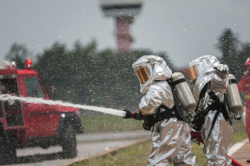Full Body Protection
Aprons, Leggings, and Sleeve Protectors
Fully sleeved and gloved apron. Separate coverings for arms and legs. Commonly worn over non-encapsulating suit.
- Provides additional splash protection of chest, forearms, and legs.
- Whenever possible, should be used over a non-encapsulating suit (instead of using a fully-encapsulating suit) to minimize potential for heat stress.
- Useful for sampling, labeling, and analysis operations. Should be used only when there is a low probability of total body contact with contaminants.
Firefighters' Protective Clothing
Gloves, helmet, running or bunker coat, running or bunker pants, and boots.
- Protects against heat, hot water, and some particles. Does not protect against gases and vapors, or chemical permeation or degradation.
- Decontamination is difficult. Should not be worn in areas where protection against gases, vapors, chemical splashes, or permeation is required.
Proximity Garments (Approach Suit)
One- or two-piece overgarment with boot covers, gloves and hood of aluminized nylon or cotton fabric. Normally worn over other protective clothing, such as chemical-protective clothing, firefighters' bunker gear, or flame-retardant coveralls.
- Protects against brief exposure to radiant heat. Does not protect against chemical permeation or degradation. Can be custom-manufactured to protect against some chemical contaminants.
- Auxiliary cooling and an SCBA should be used if the wearer may be exposed to a toxic atmosphere or needs more than 2 or 3 minutes of protection.
Knowledge Check Choose the best answer for the question.
2-3. Which type of full-body protective clothing is difficult to decontaminate?
You forgot to answer the question!

